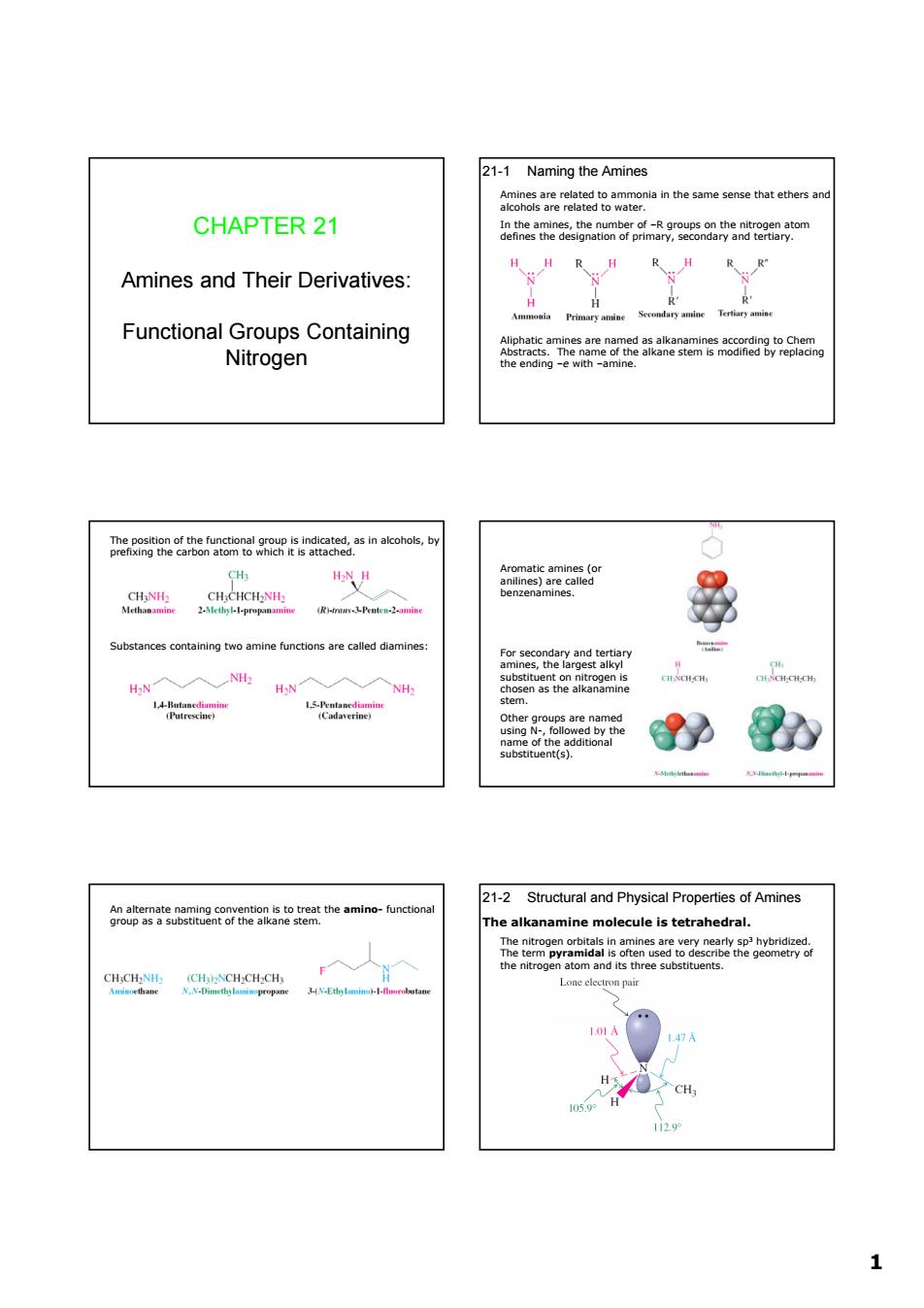
21-1 Naming the Amines CHAPTER 21 ehesme8haompnR9roaesnaggn2anon Amines and Their Derivatives: Functional Groups Containing Nitrogen g rennah .b CH H 卧 Substancesonnw amine unctionsarecalled mnes H.N 入NH HN 入N 代 2 21-2 Structural and Physical Properties of Amines 外bgah2g点h-hunconal The alkanamine molecule is tetrahedral. CICCCC 入人 1
1 CHAPTER 21 Amines and Their Derivatives: Functional Groups Containing Nitrogen 21-1 Naming the Amines Amines are related to ammonia in the same sense that ethers and alcohols are related to water. In the amines, the number of –R groups on the nitrogen atom defines the designation of primary, secondary and tertiary. Aliphatic amines are named as alkanamines according to Chem Abstracts. The name of the alkane stem is modified by replacing the ending –e with –amine. The position of the functional group is indicated, as in alcohols, by prefixing the carbon atom to which it is attached. Substances containing two amine functions are called diamines: Aromatic amines (or anilines) are called benzenamines. For secondary and tertiary amines, the largest alkyl substituent on nitrogen is chosen as the alkanamine stem. Other groups are named using N-, followed by the name of the additional substituent(s). An alternate naming convention is to treat the amino- functional group as a substituent of the alkane stem. 21-2 Structural and Physical Properties of Amines The alkanamine molecule is tetrahedral. The nitrogen orbitals in amines are very nearly sp3 hybridized. The term pyramidal is often used to describe the geometry of the nitrogen atom and its three substituents

70 ●R becmeroer ines form weaker hydrogen bonds than alcohols arStothrboingpohsanelowegandthetrsotbiltiesn coeon8gg能aotemicgaraiyebetmenthoseofthe -1617 s are soluble in le in water 21-3 Spectroscopy of the Amine Group Te chic ss deendtherte rmmesbndecmdue to enoaese2Stnhene2nogeateneS8eny 2
2 When an amine bears three different substituents (plus the lone pair of electrons), it has the potential to be optically active: At ordinary temperatures amines are not optically active, however because of a rapid isomerization process called inversion. The transition state for the inversion of an amine has been found to be between 5 and 7 kcal mol-1 for ordinary small amines. It is therefore impossible to keep an enantiomerically pure, simple di- or trialkylamine from racemizing at room temperature when the nitrogen atom is the only stereocenter. Amines form weaker hydrogen bonds than alcohols do. As a result, their boiling points are lower and their solubilities in water are lower. The boiling points of amines generally lie between those of the corresponding alkane and alcohol. Smaller amines are soluble in water (hydrogen bonding). When the hydrophobic part of an amine exceeds six carbons, the solubility in water decreases rapidly. Larger amines are essentially insoluble in water. 21-3 Spectroscopy of the Amine Group Primary and secondary amines exhibit a characteristically broad IR N-H stretching absorption between 3250 and 3500 cm-1. Primary amines show two strong peaks in this range, whereas secondary amines show only one. Primary amines also show a band near 1600 cm-1, due to a scissoring motion of the NH2 group. Tertiary amines do not show any of these signals since they do not have a hydrogen bound to nitrogen. The NMR spectra of amines often give broadened peaks similar to the OH signal in alcohols. The chemical shifts depend upon the exchange rate of protons with water in the solvent and the amount of hydrogen bonding. The lowest field hydrogens are those neighboring the nitrogen atom and are deshielded due to the nitrogen’s electronegativity
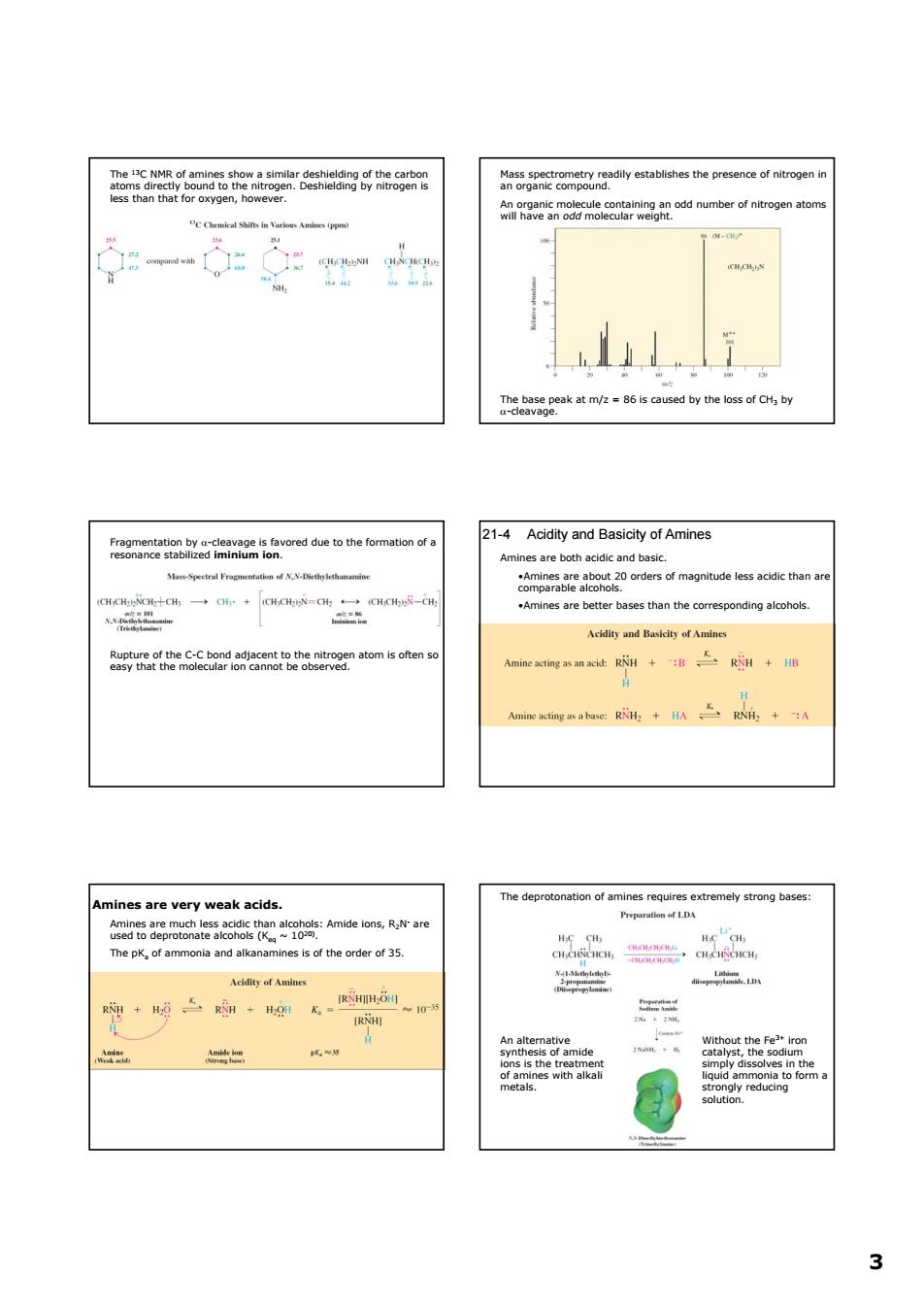
es he5ecoamegagadyestabhshesthepresenceofntrooeni s n-ct … aa femetenbgiaaeioaroreddueothefoma 21-4 Acidity and Basicity of Amines Amines are hoth acidic and hasir Mew-Speetral Frugm HCHS-CH tesasthanthecorspondingalceohos Acidity and Basicity of Amines adoeat2toa:Ameoms,RNarn The pk,of ammonia and alkanamines is of the order of 35. n 3
3 The 13C NMR of amines show a similar deshielding of the carbon atoms directly bound to the nitrogen. Deshielding by nitrogen is less than that for oxygen, however. Mass spectrometry readily establishes the presence of nitrogen in an organic compound. An organic molecule containing an odd number of nitrogen atoms will have an odd molecular weight. The base peak at m/z = 86 is caused by the loss of CH3 by α-cleavage. Fragmentation by α-cleavage is favored due to the formation of a resonance stabilized iminium ion. Rupture of the C-C bond adjacent to the nitrogen atom is often so easy that the molecular ion cannot be observed. 21-4 Acidity and Basicity of Amines Amines are both acidic and basic. •Amines are about 20 orders of magnitude less acidic than are comparable alcohols. •Amines are better bases than the corresponding alcohols. Amines are very weak acids. Amines are much less acidic than alcohols: Amide ions, R2N- are used to deprotonate alcohols (Keq ~ 1020). The pKa of ammonia and alkanamines is of the order of 35. The deprotonation of amines requires extremely strong bases: An alternative synthesis of amide ions is the treatment of amines with alkali metals. Without the Fe3+ iron catalyst, the sodium simply dissolves in the liquid ammonia to form a strongly reducing solution
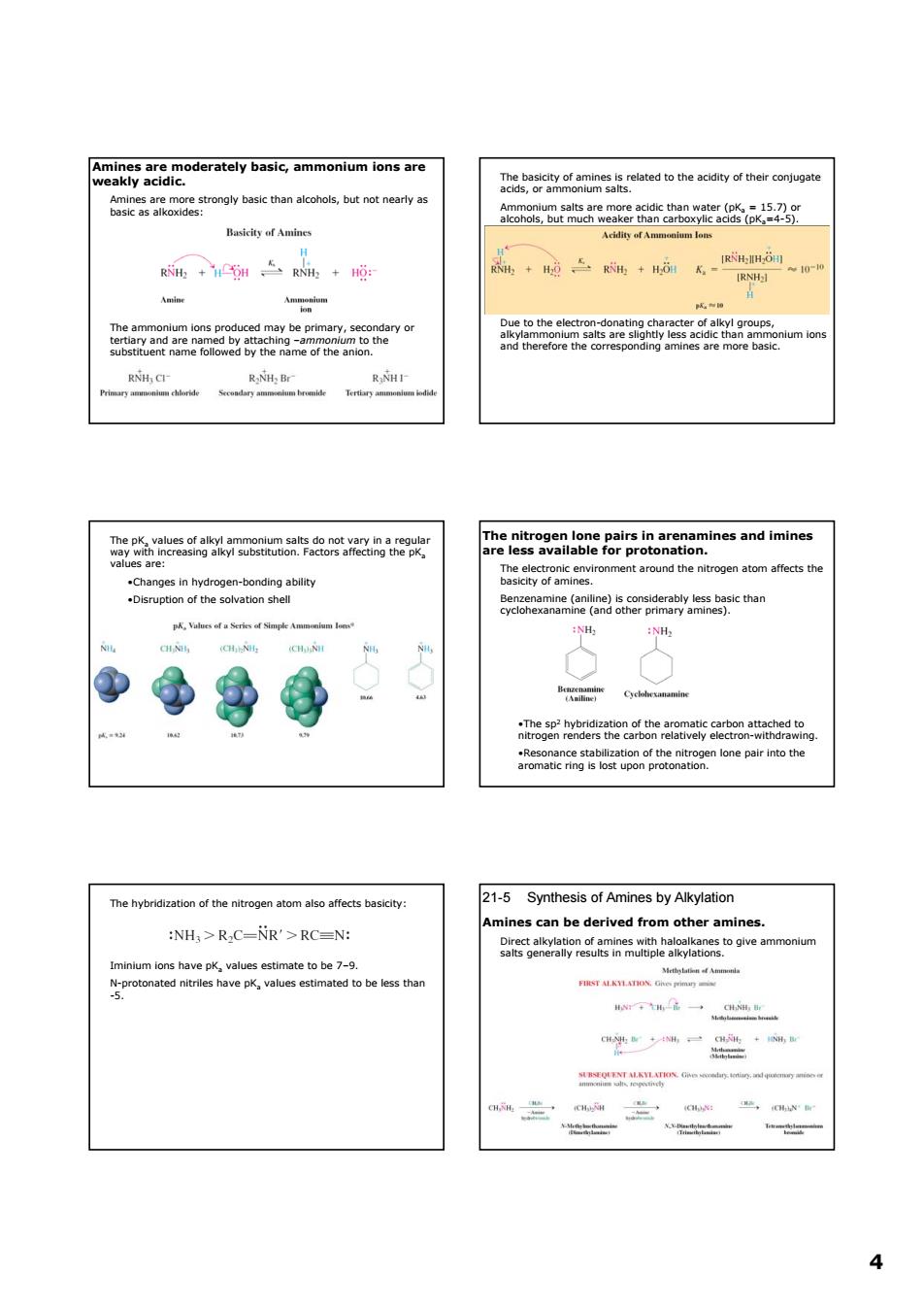
ratbasic,mmoum ions are ebaeeoammeateatedotheacdyothetcoajug 兰·临 kg8neo d the nitrogen atom affects th Ch. es in hydrogen-bonding ability cityf Disrupton of thevation shell sa6eaneea25c8rea3ycthen tegpmieaeo2semaataaatae Reonegtist8gnogen8aenloneparnothe The hybridization of the nitrogen atom also affects basicity 21-5 Synthesis of Amines by Alkylation :NH,>R,C-NR'>RC=N: Amines can be derived from other amines. to oive ammonum have values estimate to be7-. N-pro ave pK to be than a一a N a兰 4
4 Amines are moderately basic, ammonium ions are weakly acidic. Amines are more strongly basic than alcohols, but not nearly as basic as alkoxides: The ammonium ions produced may be primary, secondary or tertiary and are named by attaching –ammonium to the substituent name followed by the name of the anion. The basicity of amines is related to the acidity of their conjugate acids, or ammonium salts. Ammonium salts are more acidic than water (pKa = 15.7) or alcohols, but much weaker than carboxylic acids (pKa=4-5). Due to the electron-donating character of alkyl groups, alkylammonium salts are slightly less acidic than ammonium ions and therefore the corresponding amines are more basic. The pKa values of alkyl ammonium salts do not vary in a regular way with increasing alkyl substitution. Factors affecting the pKa values are: •Changes in hydrogen-bonding ability •Disruption of the solvation shell The nitrogen lone pairs in arenamines and imines are less available for protonation. The electronic environment around the nitrogen atom affects the basicity of amines. Benzenamine (aniline) is considerably less basic than cyclohexanamine (and other primary amines). •The sp2 hybridization of the aromatic carbon attached to nitrogen renders the carbon relatively electron-withdrawing. •Resonance stabilization of the nitrogen lone pair into the aromatic ring is lost upon protonation. The hybridization of the nitrogen atom also affects basicity: Iminium ions have pKa values estimate to be 7–9. N-protonated nitriles have pKa values estimated to be less than -5. 21-5 Synthesis of Amines by Alkylation Amines can be derived from other amines. Direct alkylation of amines with haloalkanes to give ammonium salts generally results in multiple alkylations
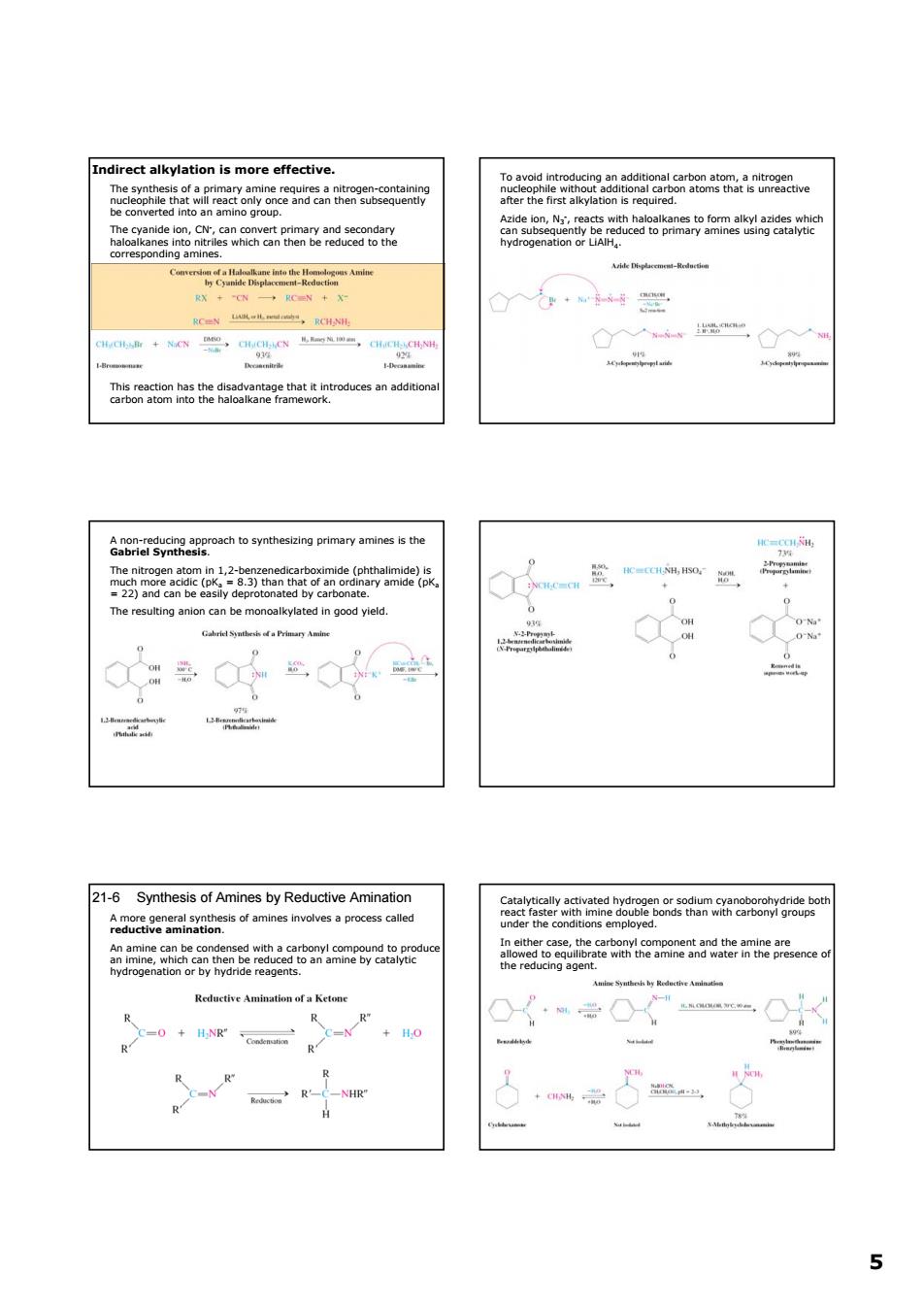
Indirect alkylation is more effective. R2e s9aeoueemwao e The res ulting anion can be m 21-6 Synthesis of Amines by Reductive Amination w 8h6rea Reductive Amination of a Kctone 5
5 Indirect alkylation is more effective. The synthesis of a primary amine requires a nitrogen-containing nucleophile that will react only once and can then subsequently be converted into an amino group. The cyanide ion, CN- , can convert primary and secondary haloalkanes into nitriles which can then be reduced to the corresponding amines. This reaction has the disadvantage that it introduces an additional carbon atom into the haloalkane framework. To avoid introducing an additional carbon atom, a nitrogen nucleophile without additional carbon atoms that is unreactive after the first alkylation is required. Azide ion, N3 - , reacts with haloalkanes to form alkyl azides which can subsequently be reduced to primary amines using catalytic hydrogenation or LiAlH4. A non-reducing approach to synthesizing primary amines is the Gabriel Synthesis. The nitrogen atom in 1,2-benzenedicarboximide (phthalimide) is much more acidic (pKa = 8.3) than that of an ordinary amide (pKa = 22) and can be easily deprotonated by carbonate. The resulting anion can be monoalkylated in good yield. 21-6 Synthesis of Amines by Reductive Amination A more general synthesis of amines involves a process called reductive amination. An amine can be condensed with a carbonyl compound to produce an imine, which can then be reduced to an amine by catalytic hydrogenation or by hydride reagents. Catalytically activated hydrogen or sodium cyanoborohydride both react faster with imine double bonds than with carbonyl groups under the conditions employed. In either case, the carbonyl component and the amine are allowed to equilibrate with the amine and water in the presence of the reducing agent

es give 21-7 Synthesis of Amines from Carboxvlic Amides sartoaMuntotanamiteanbereiucedopodiceal ylation reduction cuteacontrolled oganneaga6ca6arsahtaPeeond alkene by a strong Bimolr Elmination of Quatermarym o wwong. Heatingdegrades thisslttthe alkene. 21Mannich Reaction:Alkyaion of Eo byiminium 6
6 Reductive aminations with secondary amines give tertiary amines. Secondary amines form N,N-dialkyliminium ions rather than imines prior to the reduction step: 21-7 Synthesis of Amines from Carboxylic Amides The carbonyl unit of an amide can be reduced to produce an amine. The sequence: Alkanoylation reduction constitutes a controlled monoalkylation of amines. Primary amides can also be oxidized using bromine or chlorine in the presence of sodium hydroxide (Hofmann Rearrangement). The amine bears one less carbon than the starting material. Quaternary Ammonium Salts: Hofmann Elimination 21-8 Protonated amines can function as a leaving group in a reaction called the Hofmann elimination, in which a tetraalkylammonium salt is converted to an alkene by a strong base. In this reaction, the amine is first exhaustively methylated with excess iodomethane and then treated with wet AgOH to produce the ammonium hydroxide. Heating degrades this salt to the alkene. Hofmann Elimination, in contrast with most E2 processes, tends to give the less substituted alkenes as the major products. Mannich Reaction: Alkylation of Enols by Iminium Ions 21-9 In the Mannich Reaction, an enol functions as a nucleophile which attacks an iminium ion, derived from the condensation of a second carbonyl component with an amine. The Mannich Reaction is usually carried out by using: •A ketone •A more reactive aldehyde (usually formaldehyde) •An amine •All in an alcohol solvent containing HCl. The product of the reaction is β-aminocarbonyl product
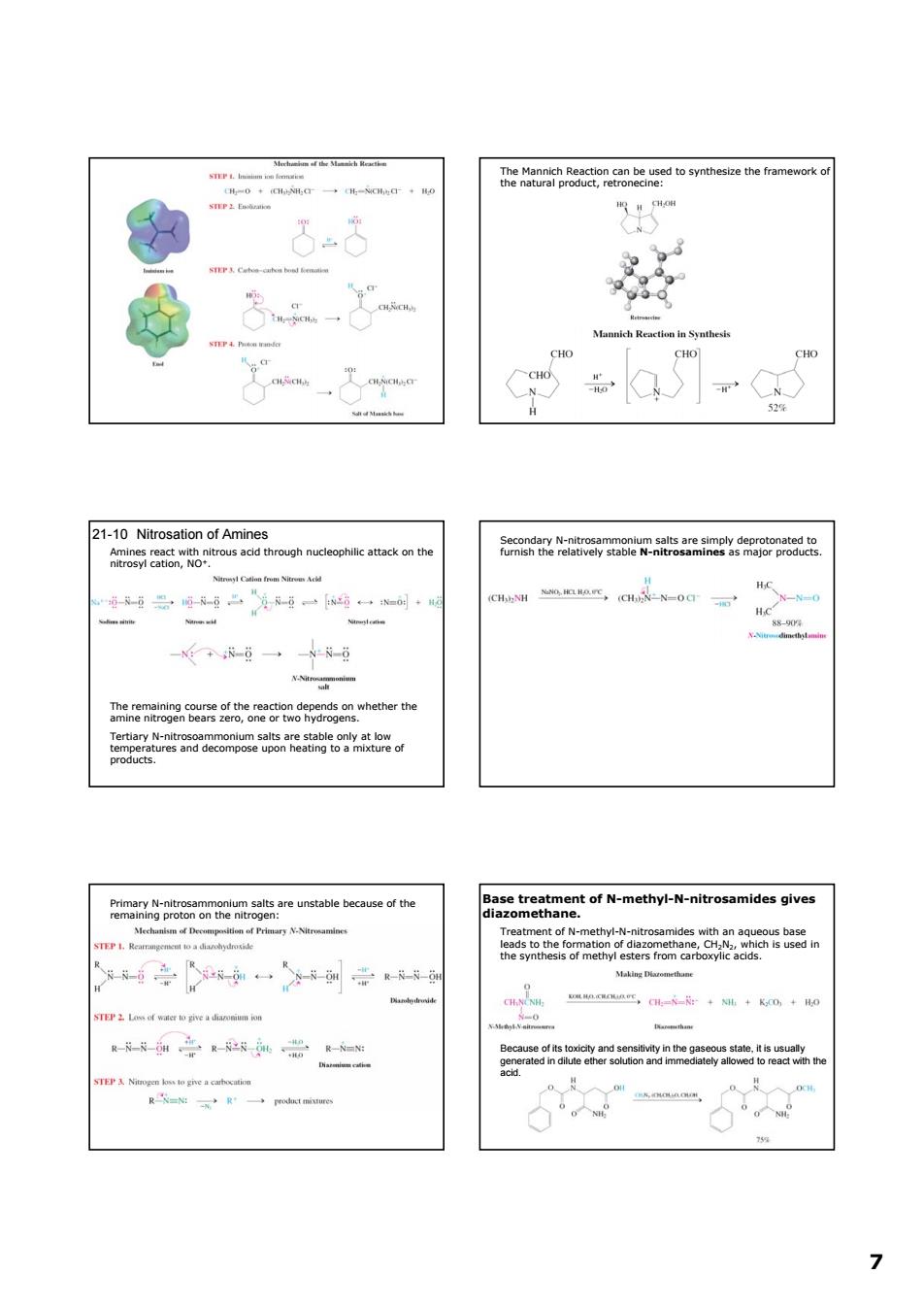
t Cehe-she he CHO CHO CHO 52% 21-10 Nitrosation of Amines f2 lavel地ne。eoog26 CHy:NH ,IC-X-00 成-6一85 aens88een6gaahehere 他。 emnYhgproromewmgsaneunstablebecausecdthe ofmeth-nmdeives 5÷一测÷8 ÷宁 之 7
7 The Mannich Reaction can be used to synthesize the framework of the natural product, retronecine: 21-10 Nitrosation of Amines Amines react with nitrous acid through nucleophilic attack on the nitrosyl cation, NO+. The remaining course of the reaction depends on whether the amine nitrogen bears zero, one or two hydrogens. Tertiary N-nitrosoammonium salts are stable only at low temperatures and decompose upon heating to a mixture of products. Secondary N-nitrosammonium salts are simply deprotonated to furnish the relatively stable N-nitrosamines as major products. Primary N-nitrosammonium salts are unstable because of the remaining proton on the nitrogen: Base treatment of N-methyl-N-nitrosamides gives diazomethane. Treatment of N-methyl-N-nitrosamides with an aqueous base leads to the formation of diazomethane, CH2N2, which is used in the synthesis of methyl esters from carboxylic acids. Because of its toxicity and sensitivity in the gaseous state, it is usually generated in dilute ether solution and immediately allowed to react with the acid

21 Important Concepts gen are desi ed on the label 21 Important Concepts 21 Important Concepts one El tron P es and moni roscopy- R- g nit M55secta 8
8 When irradiated or exposed to catalytic amounts of copper, diazomethane evolves N2 to generate the reactive carbene methylene, :CH2. Methylene reacts with alkenes by addition to form cyclopropanes, stereospecifically. 21 Important Concepts 1. Amines – Derivatives of ammonia 2. Chemical Abstracts – names amines as alkanamines and benzenamines, alkyl substituents on nitrogen are designated as N-alkyl. • A second naming system is based on the label aminoalkane. • Common names are based on the label alkylamine. 3. Nitrogen Hybridization in Amines – sp3 • Non-bonding pair of electrons functions as a substituent. The tetrahedral arrangement inverts rapidly through a planar transition state. 21 Important Concepts 4. Lone Electron Pair – held less tightly than in alcohols and ethers (nitrogen is less electronegative). Amines have less hydrogen bonding capability, higher basicity and nucleophilicity and lower acidity. 5. Spectroscopy – • IR – helps to distinguish between primary and secondary amines • NMR – indicates presence of nitrogen-bound hydrogens. Both hydrogen and carbon are deshielded by the neighboring nitrogen. • Mass Spectra – characterized by iminium ion fragments 21 Important Concepts 6. Synthesis of Amines – indirect methods (displacement with azide or cyanide, reductive amination) are superior to direct alkylation of ammonia. 7. -NR3 Group – in a quaternary amine is a good leaving group in E2 reactions. (Basis of Hofmann elimination.) 8. Nucleophilic Reactivity – Amines react with electrophilic carbon (haloalkanes, aldehydes, ketones and carboxylic acids and their derivatives)